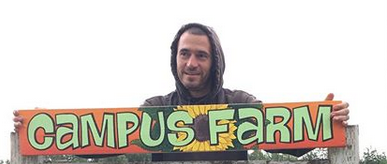written by Bachelor of Applied Science in Sustainable Practices student Carter Jones
Campus Delight: Discover the Bountiful Black Huckleberry Season! 🌿🍇
Get ready to embark on a delicious adventure as we dive into the world of black huckleberries, their vibrant history, where to find them, and how you can savor these tiny treats. Don’t miss out on this exciting opportunity to connect with nature and satisfy your taste buds – let’s dive into the berry-licious goodness that awaits you!

Description
Meet the Pacific Northwest’s Native Gem: Vaccinium ovatum, more commonly known as black huckleberry, California huckleberry, or evergreen huckleberry. These delightful little wonders are set to tantalize your taste buds! When you sink your teeth into these petite, sweet orbs, they offer a delightful ‘pop’ that’s reminiscent of your favorite popping boba. Their flavor is a close cousin to the beloved blueberry, but here’s the tip: for the ultimate taste adventure, savor a small handful all at once to balance any hint of tartness and dryness. Let’s uncover more about these tiny, berry sensations!
Location
Black Huckleberry can be found in multiple locations around campus: Inside the food forest, outside Discovery Hall, and outside CC3.
Food Forest: these tall, skinny shrubs will be among the first to greet you as they’re clustered on either side of the main sign, along with several other companion plants.
Discovery Hall: Black Huckleberry abundance lines the walkways all around the parking lot. Seriously, there are so many up here, it’s a berry palooza.
CC3 Building: These bushes have a wider spread than the other ones on campus. They line the pathway from the bus station up to the terraced entryway, making them a great snack on your way to, or from, class!
How to Identify
The black huckleberry plants here on campus are well maintained, so our Vaccinium ovatum bushes appear about 3 ft tall and quite skinny. The stalks range from brown to red in color, and tend to shoot straight up rather than branching out horizontally, though they can do so in the wild. The leaves are about 3-5 cm in length, oval-shaped, and alternate along the stem. The leaflets have a smooth feeling, and are generally a glossy dark green color, sometimes with some red variations. The berries grow very close to the stalk and start out a red color when they begin fruiting. You can tell the berries are ripe and ready to eat when they’ve turned a dark purplish black color.
Indigenous background
The historical uses of black huckleberry by indigenous communities in the Northwestern United States and Canada exemplify the connection between these native peoples and the land they inhabit. Evergreen huckleberry was a valuable resource to tribes in British Columbia and western Washington, like the Sechelt, Comox, Straits, Halkomelem, Lower Nlaka’pamux Salish, Nuu-chah-nulth, and the Quinault tribes. Evergreen huckleberries were the last fruits to be gathered in the season, especially since it’s said that they become even more delectable after freezing temperatures! Traditionally the berries were eaten fresh, often accompanied with oil. They could also be sun or smoke-dried, partially mashed, pressed into cake form, and wrapped in leaves or bark for preservation. It’s more common these days for black huckleberries to be made into jams or jellies, which is exactly what we recommend doing with your harvests!

Recipes
So what exactly can you do with these little berries?
We’ve got a couple of recipes for you to try!
The simplest and most versatile choice is, of course, jam or jelly.
We recommend this jam recipe by Kimberly Killebrew at The Daring Gourmet. It uses small quantities of ingredients so it’s the perfect choice for folks that don’t want to spend too long picking berries, especially if they’re not sure they’re going to like the result.
If you’re a huge huckleberry fan and you’ve just got a desire to put them in everything, this list provided by Bosky Dell Natives has several tantalizing, mouth-watering recipes to try. Personally, I think I’ll be making that Huckleberry pie to wow my family at Thanksgiving!
Conclusion
As we conclude our black huckleberry exploration, we hope you’re now as excited as we are about this vibrant, seasonal treasure right here on campus. Nature has blessed us with these sweet, petite delights, so why not grab a basket, gather your friends, and embark on a berry-picking adventure on campus? Take a moment to connect with the beauty of nature and indulge your senses in this delightful, seasonal bounty. Don’t wait too long; the season is fleeting, and these delicious huckleberries won’t be around forever. Happy harvesting, fellow foragers, and savor every bite of this incredible campus treasure!
Happy Harvesting! 🌿🍇
Sources
https://landscapeplants.oregonstate.edu/plants/vaccinium-ovatum
https://www.wnps.org/native-plant-directory/47-vaccinium-ovatum
https://www.daringgourmet.com/wild-huckleberry-jam/
https://www.boskydellnatives.com/description_page/Vaccinium_ovatum.htm
____________________________________________________________________________
Read about more foods and plants that are forage-worthy throughout the year! Check out the grounds and food forest sections of our blog – and see what’s In Season! https://cascadiaupdates.wordpress.com/cascadias-cornucopia-and-the-campus-grounds/























